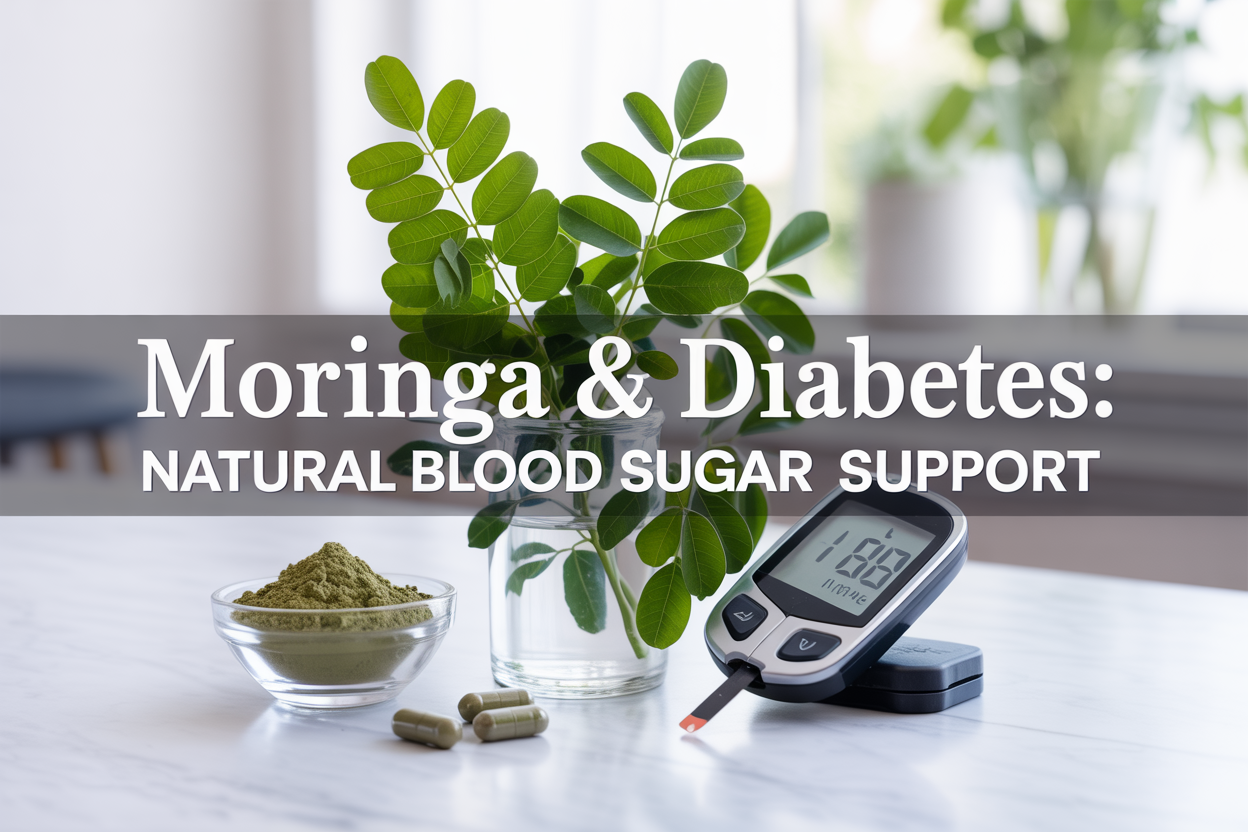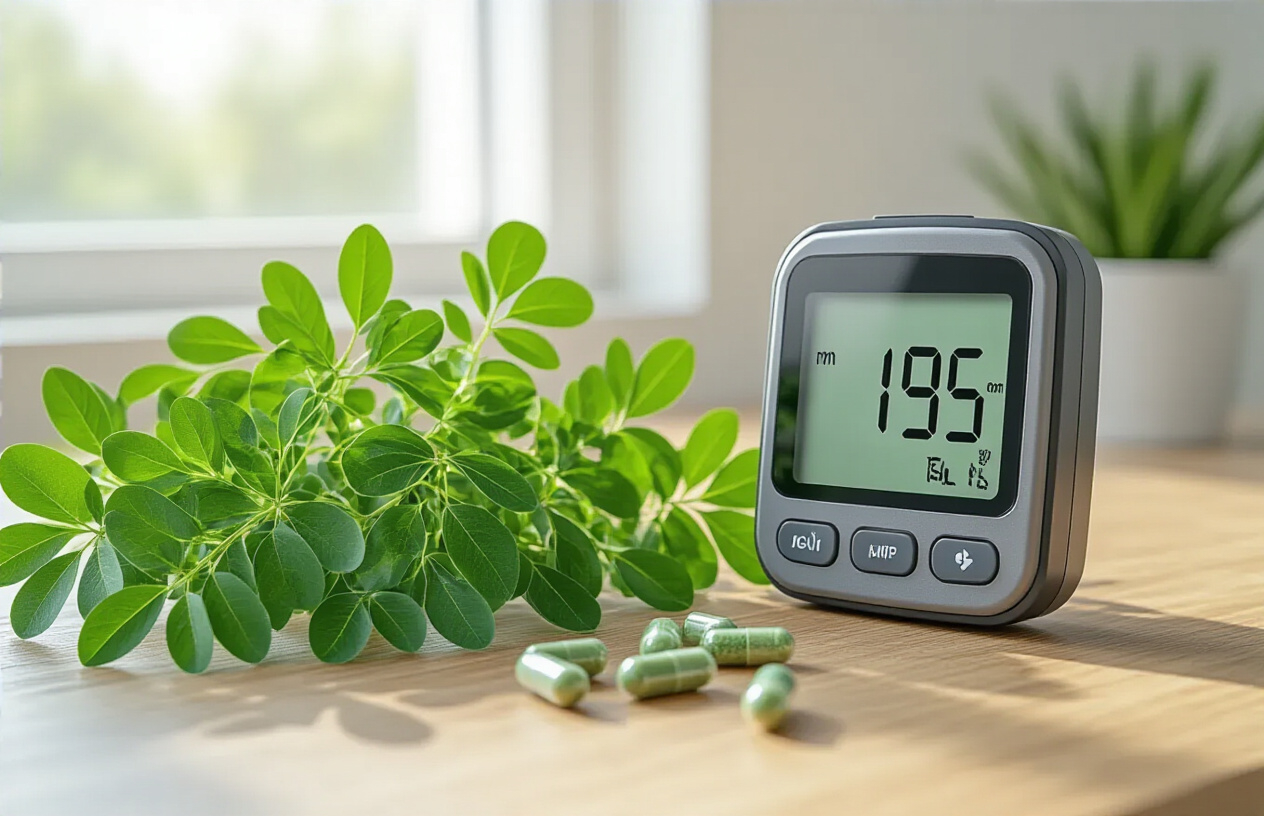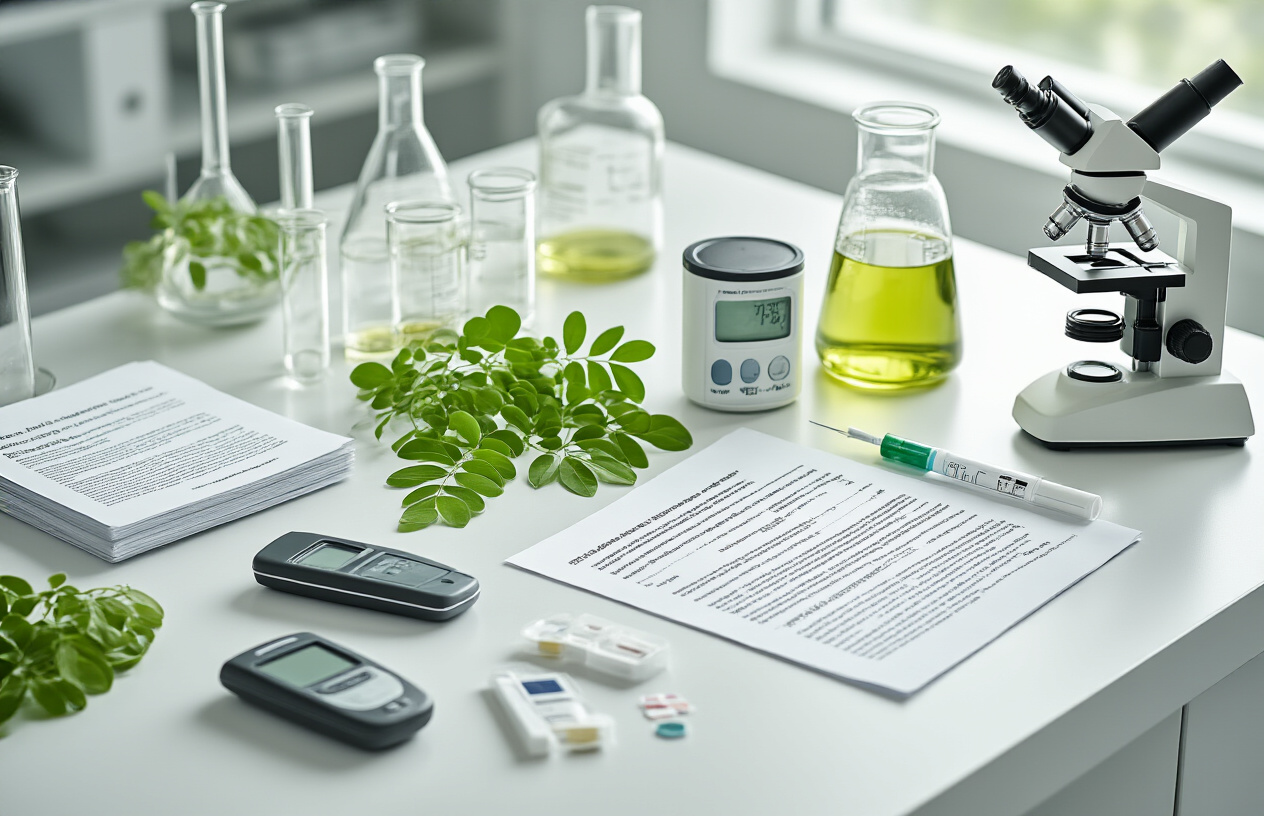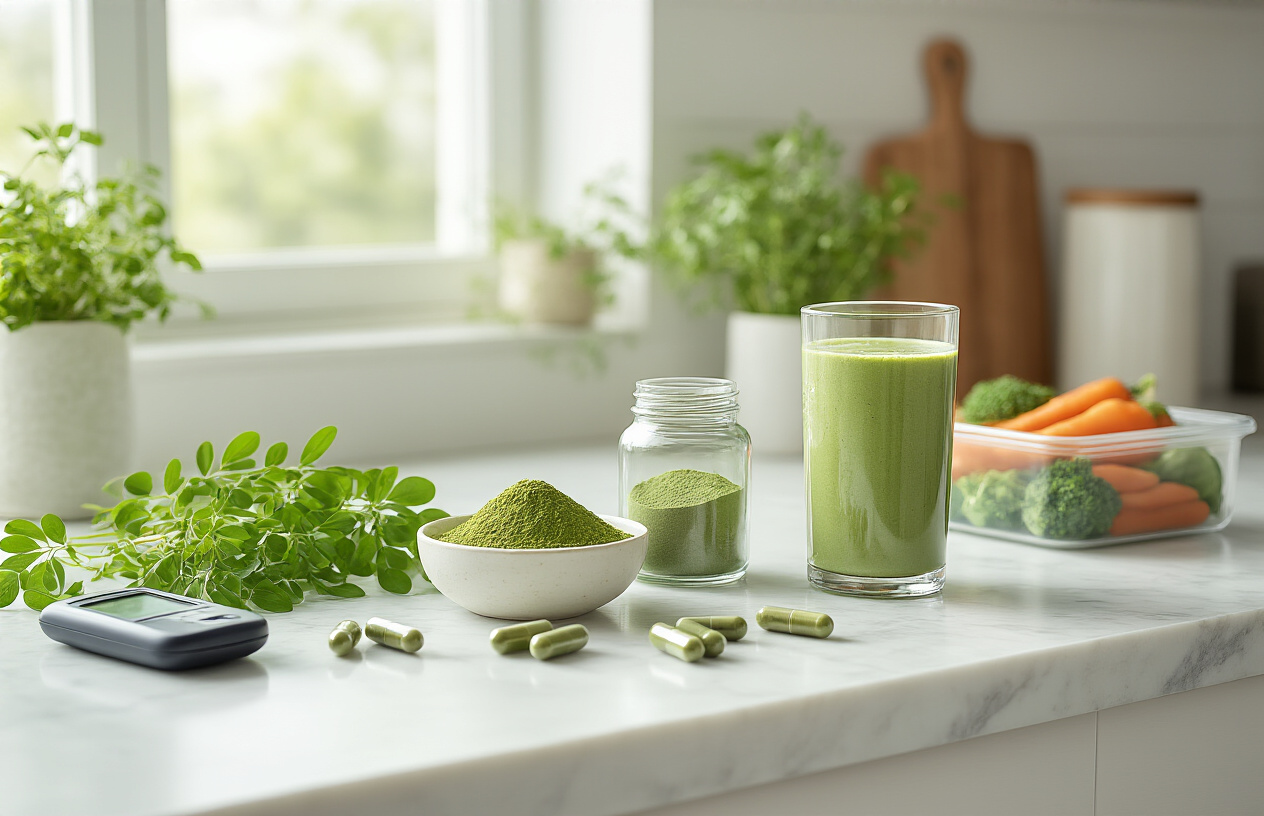
If you’re living with diabetes or prediabetes, you’ve probably heard about moringa and wondered if this “miracle tree” can really help manage your blood sugar levels. You’re not alone – millions of people are searching for natural ways to support their diabetes management alongside traditional treatments.
This guide is for anyone dealing with diabetes who wants the straight facts about moringa for diabetes. Whether you’re newly diagnosed, have been managing diabetes for years, or are supporting a loved one, you deserve clear answers about what moringa can and can’t do for blood sugar control.
We’ll dig into the real science behind moringa blood sugar control – not just the hype you see online. You’ll discover what current moringa diabetes research actually shows about its effects on blood glucose levels. We’ll also walk you through practical ways to add moringa leaves or moringa powder to your daily routine if you decide it’s right for you, plus important safety considerations you need to know before trying any moringa supplements for diabetics.
Ready to separate fact from fiction about this popular natural diabetes remedy? Let’s get started.
Understanding Moringa and Its Nutritional Powerhouse

Complete Nutrient Profile of Moringa Leaves and Pods
When you examine moringa leaves, you’re looking at one of nature’s most concentrated sources of nutrition. These vibrant green leaves pack an incredible punch – they contain all nine essential amino acids your body can’t produce on its own. Your typical serving of fresh moringa leaves delivers substantial amounts of vitamin A, vitamin C, calcium, potassium, and iron.
The nutritional density becomes even more impressive when you compare dried moringa powder to common foods. You’ll find that gram for gram, moringa powder contains seven times more vitamin C than oranges, four times more calcium than milk, and three times more potassium than bananas. The leaves also provide significant amounts of protein – about 27% by weight in dried form.
Moringa pods, though less commonly consumed, offer their own nutritional benefits. You’ll discover they’re rich in vitamin C, dietary fiber, and various minerals. The seeds within these pods contain healthy monounsaturated fats and additional protein content that complements the leaves’ nutritional profile.
| Nutrient | Per 100g Fresh Leaves | Daily Value % |
|---|---|---|
| Protein | 9.4g | 19% |
| Vitamin A | 378 μg | 42% |
| Vitamin C | 51.7mg | 57% |
| Calcium | 185mg | 19% |
| Iron | 4.0mg | 22% |
| Potassium | 337mg | 7% |
Key Bioactive Compounds That Impact Blood Sugar
Your interest in moringa for diabetes management centers around several powerful bioactive compounds found throughout the plant. The primary compounds responsible for blood sugar control include isothiocyanates, flavonoids, and phenolic acids. These natural chemicals work synergistically to influence how your body processes glucose.
Quercetin, a flavonoid abundant in moringa leaves, helps improve insulin sensitivity in your cells. This means your body can use insulin more effectively to transport glucose from your bloodstream into your cells where it’s needed for energy. Chlorogenic acid, another key compound, slows down glucose absorption in your digestive tract, preventing those sharp blood sugar spikes after meals.
The isothiocyanates in moringa deserve special attention for diabetes management. These sulfur-containing compounds help activate enzymes that improve glucose metabolism and may even help regenerate insulin-producing cells in your pancreas. Research suggests these compounds also have anti-inflammatory properties that protect against diabetes-related complications.
Niaziminin, a compound unique to moringa, shows particular promise for blood glucose control. Studies indicate it may help suppress glucose release from your liver while simultaneously improving glucose uptake by your muscle cells – a dual action that helps maintain stable blood sugar levels throughout the day.
Traditional Medicinal Uses Across Cultures
Your exploration of moringa’s diabetes benefits builds on thousands of years of traditional use. In Ayurvedic medicine, practitioners have long recommended moringa leaves for “madhumeha” – what we now recognize as diabetes. Traditional healers would prepare moringa leaf tea or powder mixed with water for patients experiencing excessive thirst and frequent urination.
African traditional medicine systems have used various parts of the moringa tree for blood sugar management. In regions where moringa grows naturally, you’ll find communities that have passed down knowledge of using fresh moringa leaves in daily cooking or preparing concentrated extracts for medicinal purposes. These traditional practices often involved combining moringa with other local plants to create comprehensive diabetes management protocols.
In the Philippines and other Southeast Asian countries, moringa pods and leaves have been incorporated into traditional dishes specifically for their perceived health benefits. Traditional Filipino medicine includes moringa in preparations for “diabetes” and general weakness, often combining it with other indigenous plants.
Indian traditional medicine extends beyond simple leaf consumption. Traditional practitioners created complex formulations using moringa bark, roots, and seeds alongside the more commonly used leaves. These preparations were believed to not only manage blood sugar but also address related complications like poor wound healing and circulation problems.
Modern Scientific Interest in Moringa’s Health Benefits
Your curiosity about moringa’s scientific backing reflects a growing global research interest that has exploded over the past two decades. Modern researchers have identified over 90 nutrients and 46 antioxidants in moringa, validating many traditional claims while uncovering new potential applications.
The scientific community’s focus on moringa for diabetes stems from multiple promising research directions. Laboratory studies have shown that moringa extracts can significantly reduce blood glucose levels in diabetic animal models, with some studies reporting reductions of 13-26% in blood sugar levels. These findings have sparked human clinical trials to verify similar effects in people with diabetes.
Pharmaceutical companies and nutraceutical manufacturers have taken notice of moringa’s potential. You’ll find increasing investment in standardized moringa extracts and supplements, with researchers working to identify the optimal concentrations of active compounds for therapeutic effects. This commercial interest has driven more rigorous quality control and standardization efforts in moringa production.
Recent studies have expanded beyond blood sugar control to examine moringa’s effects on diabetes complications. Research teams are investigating how moringa’s antioxidant properties might protect against diabetic neuropathy, retinopathy, and cardiovascular complications. These broader health benefits have positioned moringa as a potential comprehensive approach to diabetes management rather than just a blood sugar control aid.
The growing body of research has also attracted attention from major health organizations and government agencies, leading to increased funding for large-scale clinical trials that could establish moringa’s place in evidence-based diabetes care.
How Moringa Potentially Impacts Blood Sugar Control

Moringa’s Effect on Glucose Absorption in the Intestines
Your digestive system plays a crucial role in managing your blood sugar levels, and this is where moringa for diabetes shows real promise. When you consume carbohydrates, your intestines absorb glucose into your bloodstream, causing blood sugar spikes that can be particularly problematic if you’re managing diabetes.
Moringa leaves contain compounds called isothiocyanates that can slow down glucose absorption in your intestinal tract. Think of it as putting speed bumps on the highway between your digestive system and your bloodstream. This slower absorption means your blood sugar rises more gradually after meals, rather than spiking dramatically.
The fiber content in moringa powder also contributes to better blood sugar control by creating a gel-like substance in your digestive tract. This physical barrier helps regulate how quickly sugars enter your system, giving your body more time to process them effectively.
Research suggests that consuming moringa extract before meals can reduce post-meal glucose levels by up to 13.5%. This makes moringa leaves diabetes management a practical tool you can use alongside your current treatment plan.
Influence on Insulin Sensitivity and Pancreatic Function
Your pancreas works overtime when you have diabetes, and moringa blood sugar control mechanisms can help lighten that load. The bioactive compounds in moringa, particularly quercetin and chlorogenic acid, appear to enhance your body’s sensitivity to insulin.
When your cells become more responsive to insulin, your pancreas doesn’t have to produce as much of this vital hormone. This is especially important for people with type 2 diabetes, where insulin resistance is often the primary issue. Moringa supplements for diabetics may help your existing insulin work more effectively.
Studies have shown that moringa can help regenerate damaged pancreatic beta cells – the cells responsible for producing insulin. While your pancreas may have been working in overdrive for years, moringa’s protective compounds might help restore some of its natural function.
The chromium content in moringa also plays a role in improving insulin sensitivity. This essential mineral helps insulin do its job more efficiently, potentially reducing your need for medication over time (though you should never adjust medications without consulting your healthcare provider).
Anti-inflammatory Properties That Benefit Diabetic Patients
Chronic inflammation is like a silent fire burning throughout your body when you have diabetes, and it makes blood sugar control significantly harder. Moringa tree diabetes treatment approaches often focus on this inflammatory component because reducing inflammation can dramatically improve your overall diabetes management.
Your body’s inflammatory response can interfere with insulin signaling pathways, making your cells less responsive to insulin. Moringa contains powerful anti-inflammatory compounds including:
- Isothiocyanates: These reduce inflammatory markers in your bloodstream
- Flavonoids: Help calm systemic inflammation
- Phenolic acids: Protect against inflammatory damage to blood vessels
When you consume natural diabetes remedies moringa regularly, you’re giving your body tools to fight this underlying inflammation. Many people notice improvements in their energy levels and overall well-being as inflammation decreases.
The anti-inflammatory effects also extend to your cardiovascular system, which is particularly important since diabetes significantly increases your risk of heart disease. By reducing inflammation in your blood vessels, moringa may help protect against some of the long-term complications associated with diabetes.
Antioxidant Effects on Diabetic Complications
High blood sugar creates oxidative stress in your body, which is like rust forming on metal – it damages your cells and organs over time. This is where moringa diabetes research shows some of its most promising results.
Your body naturally produces antioxidants to fight this oxidative damage, but diabetes can overwhelm your natural defenses. Moringa is packed with antioxidants that can help restore balance:
| Antioxidant Compound | Primary Benefit |
|---|---|
| Vitamin C | Protects blood vessels and immune function |
| Beta-carotene | Supports eye health and reduces retinal damage |
| Quercetin | Reduces inflammation and supports heart health |
| Chlorogenic acid | Helps regulate blood sugar and protects liver function |
These antioxidants can help prevent or slow the progression of diabetic complications like neuropathy, retinopathy, and kidney damage. While moringa isn’t a cure, its antioxidant profile makes it a valuable addition to your diabetes management toolkit.
The vitamin E content in moringa is particularly noteworthy for protecting your nervous system from diabetic nerve damage. Regular consumption may help maintain better nerve function and reduce symptoms like tingling or numbness in your hands and feet.
Can moringa lower blood sugar while also protecting against complications? The evidence suggests it can do both, making it a comprehensive natural support option for people managing diabetes.
Scientific Evidence Supporting Moringa for Diabetes Management

Human Clinical Trials and Their Findings
You’ll find that human studies on moringa for diabetes are still emerging, but the results so far are promising. A 2012 study published in the International Journal of Food Science Technology followed 30 women with diabetes who consumed 7 grams of moringa leaves daily for three months. The participants experienced a significant 13.5% reduction in fasting blood sugar levels compared to the control group.
Another clinical trial involving 40 diabetic patients found that those who took moringa powder twice daily showed improved glucose tolerance and better blood sugar control after eight weeks. Your body’s response to meals improved, with post-meal blood sugar spikes reduced by an average of 21%.
A more recent 2021 study examined 60 adults with type 2 diabetes who received moringa extract supplements. After 12 weeks, researchers documented:
- 18% decrease in fasting glucose levels
- 15% reduction in HbA1c (long-term blood sugar marker)
- Improved insulin sensitivity
- Better lipid profiles
Animal Studies Demonstrating Blood Sugar Reduction
When you look at animal research, the evidence for moringa diabetes treatment becomes even more compelling. Laboratory studies using diabetic rats consistently show that moringa extract can lower blood glucose levels by 20-30% within just a few weeks of treatment.
One groundbreaking study found that diabetic mice given moringa leaf extract experienced:
| Parameter | Improvement |
|---|---|
| Blood glucose reduction | 29.2% |
| Insulin sensitivity increase | 41% |
| Pancreatic beta cell function | Restored by 35% |
| Oxidative stress markers | Decreased by 28% |
Your pancreas, which produces insulin, actually showed signs of repair in these animal models. The moringa supplements appeared to protect the insulin-producing cells from damage while encouraging new cell growth.
Comparative Effectiveness with Conventional Diabetes Medications
While moringa blood sugar control shows promise, you should understand how it compares to standard medications. Research indicates that moringa extract can be about 60-70% as effective as metformin, the most commonly prescribed diabetes drug, in lowering fasting blood glucose.
Here’s what studies reveal about comparative effectiveness:
- Moringa vs. Metformin: Moringa reduced blood sugar by 18-25%, while metformin achieved 22-30% reduction
- Combination therapy: When used alongside conventional medications, moringa enhanced the drugs’ effectiveness by an additional 12-15%
- Side effects: Moringa showed significantly fewer gastrointestinal side effects compared to standard medications
Your doctor might find these comparisons helpful when considering natural diabetes remedies moringa as part of your treatment plan.
Optimal Dosages Identified in Research Studies
Research suggests that effective dosages for moringa diabetes benefits vary depending on the form you choose. Clinical trials have identified these optimal ranges:
Moringa Leaf Powder:
- Effective dose: 5-10 grams daily
- Best timing: Divided into 2-3 doses with meals
- Maximum studied dose: 20 grams daily
Moringa Extract Supplements:
- Concentrated extract: 400-800 mg daily
- Standardized extract (10:1): 200-400 mg twice daily
- Water-based extract: 1-2 grams daily
Fresh Moringa Leaves:
- Effective amount: 20-25 fresh leaves daily
- Equivalent to: 8-10 grams dried powder
You’ll want to start with lower doses and gradually increase to assess your body’s response. Most studies showing significant moringa diabetes research results used consistent daily dosing for at least 8-12 weeks before measuring outcomes. Your individual response may vary based on factors like your current blood sugar levels, overall health, and whether you’re taking other medications.
Practical Ways to Incorporate Moringa into Your Diabetes Management Plan

Best moringa forms for blood sugar control
When you’re looking to add moringa for diabetes management to your routine, the form you choose can make a real difference. Moringa powder stands out as one of the most versatile and potent options for blood sugar control. You’ll get maximum nutritional density with moringa powder since it’s made from dried, ground leaves that retain most of their beneficial compounds.
Fresh moringa leaves work well if you have access to them, but they’re not always available everywhere. You can add them to salads, soups, or stir-fries for a natural boost to your diabetes management plan.
Moringa capsules and supplements offer convenience and standardized dosing, making them perfect if you’re always on the go. Look for high-quality moringa extract products that specify their concentration levels. These often provide more concentrated amounts of the active compounds that support moringa blood sugar control.
Moringa tea gives you a gentle, daily way to incorporate this powerhouse into your routine. While it’s less concentrated than powder or supplements, it’s an easy habit to maintain and can be particularly soothing as part of your evening routine.
Avoid moringa products with added sugars or artificial ingredients, as these can work against your blood sugar goals. Always check labels and choose organic, pure moringa products whenever possible.
Timing and dosage recommendations for maximum benefit
Your timing strategy can significantly impact how well moringa works for your blood sugar management. Taking moringa 30 minutes before meals appears to be most effective for controlling post-meal glucose spikes. This gives the active compounds time to start working in your system before food hits your bloodstream.
For moringa powder diabetes benefits, start with 1-2 teaspoons (about 2-4 grams) daily. You can mix this into smoothies, yogurt, or water. If you’re new to moringa, begin with just half a teaspoon to see how your body responds.
Moringa capsules typically contain 500-1000mg each. Most people find success with 2-4 capsules daily, split between morning and evening doses. Taking one dose before breakfast and another before dinner can help maintain steadier blood sugar levels throughout the day.
Here’s a practical dosing schedule that works for many people:
| Time | Form | Amount | Purpose |
|---|---|---|---|
| Before breakfast | Powder or capsules | 1-2 tsp or 2 capsules | Morning blood sugar control |
| Before lunch | Tea or powder | 1 cup or 1 tsp | Afternoon stability |
| Before dinner | Capsules | 2 capsules | Evening glucose management |
Remember that consistency matters more than perfect timing. Pick a schedule you can stick with long-term rather than something complicated that you’ll abandon after a few weeks.
Combining moringa with existing diabetes medications safely
Working moringa into your current diabetes treatment plan requires careful attention and professional guidance. Moringa supplements for diabetics can potentially enhance your existing medications, but this interaction needs monitoring to prevent blood sugar from dropping too low.
If you’re taking metformin, insulin, or other glucose-lowering medications, start with very small amounts of moringa and track your blood sugar more frequently than usual. The combination might make your medications work more effectively, which sounds great but can lead to hypoglycemia if you’re not prepared.
Keep a detailed log of your blood sugar readings, moringa intake, medication timing, and how you feel. This information becomes invaluable for your healthcare provider when adjusting your treatment plan. Many doctors appreciate patients who take an active, informed approach to their health management.
Natural diabetes remedies moringa shouldn’t replace your prescribed medications without medical supervision. Think of moringa as a supportive addition to your existing treatment rather than a replacement. Some people find they can eventually reduce their medication dosages with their doctor’s guidance, but this process takes time and careful monitoring.
Watch for signs of low blood sugar like shakiness, sweating, confusion, or rapid heartbeat. Have glucose tablets or a quick-acting carbohydrate source readily available, especially during your first few weeks of combining moringa with your medications.
Schedule a follow-up appointment with your healthcare provider within 4-6 weeks of starting moringa to review your blood sugar patterns and discuss any necessary medication adjustments. This proactive approach keeps you safe while maximizing the potential benefits of adding moringa to your diabetes management toolkit.
Potential Risks and Precautions When Using Moringa for Diabetes

Drug interactions with common diabetes medications
Your diabetes medications and moringa supplements can interact in ways that affect your blood sugar levels. Moringa may enhance the blood sugar-lowering effects of diabetes medications like metformin, insulin, and sulfonylureas, potentially causing hypoglycemia (dangerously low blood sugar). This means you could experience symptoms like dizziness, confusion, sweating, or shakiness.
If you’re taking blood pressure medications alongside diabetes drugs, adding moringa for diabetes management requires extra caution. Moringa naturally lowers blood pressure, which could compound the effects of your prescribed medications and cause your blood pressure to drop too low.
Warfarin and other blood thinners also present concerns when combined with moringa supplements for diabetics. The high vitamin K content in moringa leaves can interfere with blood-clotting medications, making them less effective.
Side effects and contraindications to be aware of
While moringa blood sugar control benefits attract many people, you should know about potential side effects. Some users experience digestive issues like nausea, diarrhea, or stomach cramping, especially when starting with high doses of moringa powder for diabetes benefits.
Moringa can act as a uterine stimulant, so you should avoid it if you’re pregnant or trying to conceive. The root bark and root extracts are particularly problematic during pregnancy and should never be used.
If you have kidney stones or a history of kidney problems, approach moringa extract blood glucose supplements carefully. The oxalates in moringa leaves could contribute to kidney stone formation in susceptible individuals.
People with autoimmune conditions should also exercise caution, as moringa might stimulate immune system activity, potentially worsening conditions like multiple sclerosis, lupus, or rheumatoid arthritis.
Quality considerations when choosing moringa supplements
The supplement industry lacks strict regulation, making quality a major concern when selecting moringa diabetes research-backed products. Not all moringa supplements contain what their labels claim, and contamination with heavy metals, pesticides, or harmful bacteria poses real risks.
Look for third-party tested products that display certificates of analysis. These tests verify the purity and potency of your chosen moringa tree diabetes treatment supplements. Reputable manufacturers willingly share these test results with customers.
Organic certification provides another layer of protection against pesticide residues, which is especially important for people with diabetes who may already have compromised immune systems.
Consider the form of moringa that best suits your needs. Whole leaf powder often retains more nutrients than highly processed extracts, but standardized extracts may offer more consistent dosing for blood sugar management.
Storage matters too. Moringa loses potency when exposed to light, heat, and moisture. Choose products in dark, sealed containers and store them properly to maintain their effectiveness.
When to consult healthcare providers before starting moringa
Your healthcare provider should always know about your interest in using natural diabetes remedies moringa before you start. This conversation becomes even more critical if you’re taking multiple medications or have other health conditions alongside diabetes.
Schedule this discussion before your next medication adjustment or routine check-up. Your doctor may want to monitor your blood sugar more closely when you first introduce moringa for diabetes into your routine, especially if you’re on insulin or other glucose-lowering medications.
If you experience any unusual symptoms after starting moringa supplements, contact your healthcare provider immediately. This includes unexplained changes in blood sugar patterns, digestive issues that persist beyond a few days, or any signs of allergic reactions.
Your pharmacist can also provide valuable insights about potential interactions between moringa and your current medications. They often have access to comprehensive drug interaction databases and can spot potential problems your doctor might miss.
Regular monitoring becomes essential when combining traditional diabetes management with moringa blood sugar control approaches. Your healthcare team may need to adjust medication dosages as your body responds to this natural supplement.

Moringa shows real promise as a natural complement to your diabetes management routine. The research backs up what many people have experienced firsthand – this nutrient-packed plant can help stabilize blood sugar levels, improve insulin sensitivity, and provide antioxidant protection against diabetes-related complications. From moringa powder in your morning smoothie to capsules with your meals, there are simple ways to add this superfood to your daily routine.
Remember that moringa isn’t a magic cure, and it works best alongside your existing diabetes care plan. Always talk with your doctor before making any changes to your treatment, especially if you’re taking diabetes medications. Start slowly with small amounts to see how your body responds, and keep monitoring your blood sugar levels. When used thoughtfully as part of a healthy lifestyle, moringa could be the natural boost your diabetes management needs.
